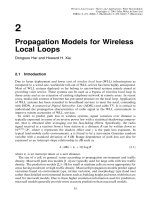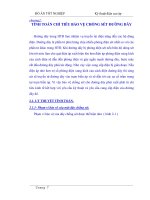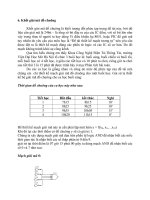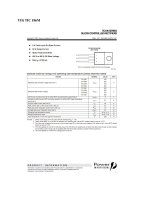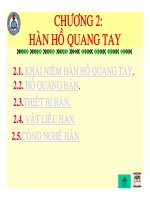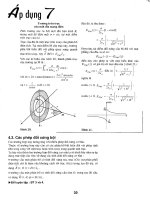Read first - Then drive safely P2 pps
Bạn đang xem bản rút gọn của tài liệu. Xem và tải ngay bản đầy đủ của tài liệu tại đây (476.64 KB, 20 trang )
Child restraints for infants and small children of
various sizes are offered by several manufactur-
ers. When selecting any child restraint, keep the
following points in mind:
● Choose only a restraint with a label certifying
that it complies with Federal Motor Vehicle
Safety Standard 213 or Canadian Motor
Vehicle Safety Standard 213.
● Check the child restraint in your vehicletobe
sure it is compatible with the vehicle’s seat
and seat belt system.
● If the child restraint is compatible with your
vehicle, place your child in the child restraint
and check the various adjustments to be
sure the child restraint is compatible with
your child. Choose a child restraint that is
designed for your child’s height and weight.
Always follow all recommended procedures.
All U.S. states and Canadian provinces or
territories require that infants and small
children be restrained in an approved child
restraint at all times while the vehicle is
being operated.
WARNING
● Improper use of a child restraint can
increase the risk or severity of injury for
both the child and other occupants of
the vehicle.
● Follow all of the child restraint manu-
facturer’s instructions for installation
and use. When purchasing a child re-
straint, be sure to select one which will
fit your child and vehicle. It may not be
possible to properly install some types
of child restraints in your vehicle.
● If the child restraint is not anchored
properly, the risk of a child being in-
jured in a collision or a sudden stop
greatly increases.
● Adjustable seatbacks should be posi-
tioned to fit the child restraint, but as
upright as possible.
● After attaching the child restraint, test it
before you place the child in it. Push it
from side to side. Try to tug it forward
and check to see if the belt holds the
restraint in place. The child restraint
should not move more than 1 inch (25
mm). If the restraint is not secure,
tighten the belt as necessary, or put the
restraint in another seat and test it
again. You may need to try a different
child restraint. Not all child restraints fit
in all types of vehicles.
● If you must install a front facing child
restraint in the front seat, see “Child
restraint installation on front passenger
seat” later in this section.
● When your child restraint is not in use,
keep it secured with a seat belt to pre-
vent it from being thrown around in
case of a sudden stop or accident.
CAUTION
Remember that a child restraint left in a
closed vehicle can become very hot.
Check the seating surface and buckles
before placing your child in the child
restraint.
Safety—Seats, seat belts and supplemental restraint system 1-15
੬ REVIEW COPY—
2006 Sentra (b15)
Owners Manual—USA_English (nna)
03/01/06—debbie
੭
CHILD RESTRAINT INSTALLATION
ON REAR SEAT CENTER OR
OUTBOARD POSITIONS
WARNING
● The three-point seat belt in your vehicle
is equipped with an automatic locking
mode retractor which must be used
when installing a child restraint.
● Failure to use the retractor’s locking
mode will result in the child restraint
not being properly secured. The re-
straint could tip over or otherwise be
unsecured and cause injury to the child
in a sudden stop or collision.
● When installing a child restraint system
in the rear center position, both the
center seat belt connector tongue and
buckle tongue must be secured.
Front facing
When you install a child restraint in the rear seat,
follow these steps:
Front Facing (center) — step 1
WRS0487
Front Facing (outboard) — step 1
WRS0493
1-16 Safety—Seats, seat belts and supplemental restraint system
੬ REVIEW COPY—
2006 Sentra (b15)
Owners Manual—USA_English (nna)
03/01/06—debbie
੭
᭺
1
Position the child restraint on the seat. Al-
ways follow the restraint manufacturer’s in-
structions. The back of the child restraint
should be secured against the vehicle seat
back. If necessary, adjust or remove thehead
restraint to obtain the correct child restraint
fit. See “Head restraint adjustment” earlier in
this section. If the head restraint is removed,
store it in a secure place. Be sure to install
the head restraint when the child restraint is
removed. If the seating position does not
have an adjustable head restraint and it is
interfering with the proper child restraint fit,
try another seating position or a different
child restraint.
᭺
2
Route the seat belt tongue through the child
restraint and insert it into the buckle until you
hear and feel the latch engage.
Be sure to follow the child restraint manu-
facturer’s instructions for belt routing.
᭺
3
Pull on the shoulder belt until all of the belt is
fully extended. At this time, the seat belt
retractor is in the automatic locking mode
(child restraint mode). It reverts back to
emergency locking mode when the seat belt
is fully retracted.
Front Facing — step 2
WRS0250
Front Facing — step 3
LRS0458
Safety—Seats, seat belts and supplemental restraint system 1-17
੬ REVIEW COPY—
2006 Sentra (b15)
Owners Manual—USA_English (nna)
03/01/06—debbie
੭
᭺
4
Allow the seat belt to retract. Pull up on the
shoulder belt to remove any slack in the belt.
᭺
5
Before placing the child in the child restraint,
use force to push the child restraint from
side to side, and tug it forward to make sure
that it is securely held in place. It should not
move more than 1 inch (25 mm). If it does
move more than 1 inch (25 mm), pull again
on the shoulder belt to further tighten the
child restraint. If unable to properly secure
the restraint move the restraint to another
rear seating position and try again, or try a
different child restraint. Not all child re-
straints fit in all types of vehicles.
6. Check that the retractor is in the automatic
locking mode by trying to pull more seat belt
out of the retractor. If you cannot pull any
more belt webbing out of the retractor, the
retractor is in the automatic locking mode.
7. Check to make sure that the child restraint is
properly secured prior to each use. If the
seat belt is not locked, repeat steps 3
through 6.
After the child restraint is removed and the seat
belt is fully retracted, the automatic locking mode
(child restraint mode) is canceled.
Front Facing — step 4
LRS0457
Front Facing — step 5
WRS0252
1-18 Safety—Seats, seat belts and supplemental restraint system
੬ REVIEW COPY—
2006 Sentra (b15)
Owners Manual—USA_English (nna)
03/02/06—betty
੭
Rear facing
When you install a child restraint in the rear seat,
follow these steps:
᭺
1
Position the child restraint on the seat. Al-
ways follow the restraint manufacturer’s in-
structions.
᭺
2
Route the seat belt tongue through the child
restraint and insert it into the buckle until you
hear and feel the latch engage.
Be sure to follow the child restraint manu-
facturer’s instructions for belt routing.
Rear Facing (center) — step 1
LRS0488
Rear Facing (outboard) — step 1
LRS0406
Rear Facing — step 2
LRS0489
Safety—Seats, seat belts and supplemental restraint system 1-19
੬ REVIEW COPY—
2006 Sentra (b15)
Owners Manual—USA_English (nna)
03/01/06—debbie
੭
᭺
3
Pull on the shoulder belt until all of the belt is
fully extended. At this time, the seat belt
retractor is in the automatic locking mode
(child restraint mode). It reverts to emer-
gency locking mode when the seat belt is
fully retracted.
᭺
4
Allow the seat belt to retract. Pull up on the
shoulder belt to remove any slack in the belt.
᭺
5
Before placing the child in the child restraint,
use force to push the child restraint from
side to side, and tug it forward to make sure
that it is securely held in place. It should not
move more than 1 inch (25 mm). If it does
move more than 1 inch (25 mm), pull again
on the shoulder belt to further tighten the
child restraint. If unable to properly secure
the restraint move the restraint to another
rear seating position and try again , or try a
different child restraint. Not all child re-
straints fit in all types of vehicles.
Rear Facing — step 3
LRS0490
Rear Facing — step 4
LRS0491
Rear Facing — step 5
LRS0492
1-20 Safety—Seats, seat belts and supplemental restraint system
੬ REVIEW COPY—
2006 Sentra (b15)
Owners Manual—USA_English (nna)
03/01/06—debbie
੭
6. Check that the retractor is in the automatic
locking mode by trying to pull more seat belt
out of the retractor. If you cannot pull any
more seat belt webbing out of the retractor,
the retractor is in the automatic locking
mode.
7. Check to make sure that the child restraint is
properly secured prior to each use. If the belt
is not locked, repeat steps 3 through 6.
After the child restraint is removed and the seat
belt fully retracted, the automatic locking mode
(child restraint mode) is canceled.
WRS0154
Safety—Seats, seat belts and supplemental restraint system 1-21
੬ REVIEW COPY—
2006 Sentra (b15)
Owners Manual—USA_English (nna)
03/01/06—debbie
੭
LATCH (Lower Anchors and Tethers
for CHildren) SYSTEM
The LATCH (Lower Anchors and Tethers for
CHildren) anchor points are located in the seat
cushions of the rear outboard seating positions
only. Do not attempt to install a child restraint in
the center position using the LATCH anchors.
The LATCH system anchors are located at the
rear of the seat cushion near the seatback. A
label is attached to the seat back to help you
locate the LATCH system anchors.
WARNING
● Attach LATCH system compatible child
restraints only at the locations shown. If
a child restraint is not secured properly,
your child could be seriously injured or
killed in an accident.
● Do not secure a child restraint in the
center rear seating position using the
LATCH system anchors. The child re-
straint will not be secured properly.
● The LATCH system anchors are de-
signed to withstand only those loads
imposed by correctly fitted child re-
straints. Under no circumstance are
they to be used for adult seat belts or
harnesses.
Some child restraints include two rigid or
webbing-mounted attachments that can be con-
nected to two anchors located at certain seating
positions in your vehicle. This system is known as
the LATCH system. This system may also be
referred to as the ISOFIX or ISOFIX compatible
system. With this system, you do not have to use
a vehicle seat belt to secure the child restraint.
Your vehicle is equipped with special anchor
points that are used with LATCH system compat-
ible child restraints. Check your child restraint for
a label stating that it is compatible with the
LATCH system. This information may also be in
the instructions provided by the child restraint
manufacturer. If you have such a child restraint,
refer to the illustration for the seating positions
equipped with LATCH system anchors which can
be used to secure the child restraint.
LATCH child restraints generally require the use
of a top tether strap. See “Top tether strap child
restraint” later in this section for installation in-
structions.
When installing a child restraint, carefully read
and follow the instructions in this manual and
those supplied with the child restraint.
When you install a LATCH system compatible
child restraint to the lower anchor attachments,
follow these steps:
WARNING
Inspect the lower anchors by inserting
your fingers into the lower anchor area
and feeling to make sure there are no
obstructions over the LATCH system an-
chors, such as seat belt webbing or seat
cushion material. The child restraint will
not be secured properly if the LATCH sys-
tem anchors are obstructed.
1. To install the LATCH system compatible
child restraint, insert the child restraint
LATCH system anchor attachments into the
anchor points on the seat. If the child re-
straint is equipped with a top tether, see
“Top tether strap child restraint” later in this
section for installation instructions.
2. After attaching the child restraint and before
placing the child in it, use force to push the
child restraint from side to side and tug it
forward to make sure that the child restraint
is securely held in place. It should not move
more than 1 inch (25 mm) .
3. Check to make sure that the child restraint is
properly secured prior to each use.
1-22 Safety—Seats, seat belts and supplemental restraint system
੬ REVIEW COPY—
2006 Sentra (b15)
Owners Manual—USA_English (nna)
03/01/06—debbie
੭
TOP TETHER STRAP CHILD
RESTRAINT
If your child restraint has a top tether strap,itmust
be secured to one of the provided anchor points
᭺
A
. First, secure the child restraint with the rear
seat belt.
Remove the anchor cover
᭺
B
from the anchor
point which is located directly behind the child
seat.
Type A
WRS0155
Type B
WRS0156
Safety—Seats, seat belts and supplemental restraint system 1-23
੬ REVIEW COPY—
2006 Sentra (b15)
Owners Manual—USA_English (nna)
03/01/06—debbie
੭
Secure the top tether strap to the anchor bracket.
Tighten the strap according to the manufactur-
er’s instructions to remove any slack.
WARNING
Child restraint anchor points are designed
to withstand only those loads imposed by
correctly fitted child restraints. Under no
circumstances are they to be used for
adult seat belts or harnesses.
Anchor point locations
Anchor points are located on the rear parcel shelf
finisher.
If you have any questions when installing a
top strap child restraint on the rear seat,
consult your NISSAN dealer for details.
CHILD RESTRAINT INSTALLATION
ON FRONT PASSENGER SEAT
WARNING
● Never install a rear-facing child re-
straint in the front passenger seat.
Supplemental front air bags inflate with
great force. A rear-facing child restraint
could be struck by the supplemental
front air bag in a crash and could seri-
ously injure or kill your child.
● NISSAN recommends that child re-
straints be installed in the rear seat.
However, if you must install a forward-
facing child restraint in the front pas-
senger seat, move the passenger seat
to the rearmost position.
● A child restraint with a top tether strap
should not be used in the front passen-
ger seat.
● The three-point seat belt in your vehicle
is equipped with an automatic locking
mode retractor which must be used
when installing a child restraint.
WRS0256 WRS0378
1-24 Safety—Seats, seat belts and supplemental restraint system
੬ REVIEW COPY—
2006 Sentra (b15)
Owners Manual—USA_English (nna)
03/01/06—debbie
੭
● Failure to use the retractor’s locking
mode will result in the child restraint
not being properly secured. The re-
straint could tip over or otherwise be
unsecured and cause injury to the child
in a sudden stop or collision.
If you must install a child restraint in the front seat,
follow these steps:
᭺
1
Position the child restraint on the front pas-
senger seat. It should be placed in a
front-facing direction only. Move the
seat to the rearmost position. Adjust the
head restraint to its highest position. Always
follow the child restraint manufacturer’s in-
structions. Child restraints for infants
must be used in the rear-facing direc-
tion and therefore must not be used in
the front seat.
The back of the child restraint should be
secured against the vehicle seat back. If
necessary, adjust or remove the head re-
straint to obtain the correct child restraint fit.
See “Head restraint adjustment” earlier in
this section. If the head restraint is removed,
store it in a secure place. Be sure to install
the head restraint when the child restraint is
removed. If the seating position does not
have an adjustable head restraint and it is
interfering with the proper child restraint fit,
try another seating position or a different
child restraint.
Front Facing — step 1
WRS0379
Safety—Seats, seat belts and supplemental restraint system 1-25
੬ REVIEW COPY—
2006 Sentra (b15)
Owners Manual—USA_English (nna)
03/01/06—debbie
੭
᭺
2
Route the seat belt tongue through the child
restraint and insert it into the buckle until you
hear and feel the latch engage.
Be sure to follow the child restraint manu-
facturer’s instructions for belt routing.
᭺
3
Pull on the shoulder belt until all of the belt is
fully extended. At this time, the seat belt
retractor is in the automatic locking mode
(child restraint mode). It reverts to emer-
gency locking mode when the seat belt is
fully retracted.
᭺
4
Allow the seat belt to retract slightly. Pull up
on the shoulder belt to remove any slack in
the belt.
Front Facing — step 2
WRS0159
Front Facing — step 3
WRS0160
Front Facing — step 4
LRS0457
1-26 Safety—Seats, seat belts and supplemental restraint system
੬ REVIEW COPY—
2006 Sentra (b15)
Owners Manual—USA_English (nna)
03/01/06—debbie
੭
᭺
5
Before placing the child in the child restraint,
use force to push the child restraint from
side to side, and tug it forward to make sure
that it is securely held in place. It should not
move more than 1 inch (25 mm). If it does
move more than 1 inch (25 mm), pull again
on the shoulder belt to further tighten the
child restraint. If unable to properly secure
the restraint move the restraint to another
seating position and try again , or try a differ-
ent child restraint. Not all child restraints fit in
all types of vehicles.
6. Check that the retractor is in the automatic
locking mode by trying to pull more seat belt
out of the retractor. If you cannot pull any
more belt webbing out of the retractor, the
retractor is in the automatic locking mode.
7. Check to make sure the child restraint is
properly secured prior to each use. If the
seat belt is not locked, repeat steps 3
through 6.
After the child restraint is removed and the seat
belt is fully retracted, the automatic locking mode
(child restraint mode) is canceled.
PRECAUTIONS ON BOOSTER
SEATS
WARNING
● Infants and small children should al-
ways be placed in an appropriate child
restraint while riding in the vehicle.
Failure to use a child restraint or
booster seat can result in serious injury
or death.
● Infants and small children should never
be carried on your lap. It is not possible
for even the strongest adult to resist the
forces of a severe accident. The child
could be crushed between the adult and
parts of the vehicle. Also, do not put the
same seat belt around both your child
and yourself.
● NISSAN recommends that the booster
seat be installed in the rear seat. Ac-
cording to accident statistics, children
are safer when properly restrained in
the rear seat than in the front seat.
Front Facing — step 5
WRS0380
BOOSTER SEATS
Safety—Seats, seat belts and supplemental restraint system 1-27
੬ REVIEW COPY—
2006 Sentra (b15)
Owners Manual—USA_English (nna)
03/01/06—debbie
੭
● A booster seat must only be installed in
a seating position that has a
lap/shoulder belt. Failure to use a
three-point type seat belt with a
booster seat can result in a serious in-
jury in sudden stop or collision.
● An improperly installed booster seat
could lead to serious injury or death in
an accident.
WARNING
● Do not use towels, books, pillows or
other items in place of a booster seat.
Items such as these may move during
normal driving or a collision and result
in serious injury or death. Booster seats
are designed to be used with a
lap/shoulder belt. Booster seats are de-
signed to properly route the lap and
shoulder portions of the seat belt over
the strongest portions of a child’s body
to provide the maximum protection dur-
ing a collision.
Booster seats of various sizes are offered by
several manufacturers. When selecting any
booster seat, keep the following points in mind:
● Choose only a booster seat with a label
certifying that it complies with Federal Motor
Vehicle Safety Standard 213 or Canadian
Motor Vehicle Safety Standard 213.
● Check the booster seat in your vehicle to be
sure it is compatible with the vehicle’s seat
and seat belt system.
● Make sure the child’s head will be properly
supported by the booster seat or vehicle
seat. The seat back must be at or above the
center of the child’s ears. For example, if a
LRS0455 LRS0453
1-28 Safety—Seats, seat belts and supplemental restraint system
੬ REVIEW COPY—
2006 Sentra (b15)
Owners Manual—USA_English (nna)
03/01/06—debbie
੭
low back booster seat
᭺
1
is chosen, the
vehicle seat back must be at or above the
center of the child’s ears. If the seat back is
lower than the center of the child’s ears, a
high back booster seat
᭺
2
should be used.
● If the booster seat is compatible with your
vehicle, place your child in the booster seat
and check the various adjustments to be
sure the booster seat is compatible with your
child. Always follow all recommended pro-
cedures.
All U.S. states and Canadian provinces or
territories require that infants and small
children be restrained in an approved child
restraint at all times while the vehicle is
being operated.
WARNING
● Improper use of a booster seat can in-
crease the risk or severity of injury for
both the child and other occupants of
the vehicle.
● Follow all of the booster seat manufac-
turer’s instructions for installation and
use. When purchasing a booster seat,
be sure to select one which will fit your
child and vehicle. It may not be possible
to properly install some types of
booster seats in your vehicle.
● If the booster seat and seat belt is not
used properly, the risk of a child being
injured in a collision or a sudden stop
greatly increases.
● Adjustable seatbacks should be posi-
tioned to fit the booster seat, but as
upright as possible.
● After placing the child in the booster
seat and fastening the seat belt, make
sure the shoulder portion of the belt is
away from the child’s face and neck and
the lap portion of the belt does not
cross the abdomen.
● Do not put the shoulder belt behind the
child or under the child’s arm. If you
must install a booster seat in the front
seat, see “Booster seat installation on
front passenger seat” later in this
section.
● When your booster seat is not in use,
keep it secured with a seat belt to pre-
vent it from being thrown around in
case of a sudden stop or accident.
CAUTION
Remember that a booster seat left in a
closed vehicle can become very hot.
Check the seating surface and buckles
before placing your child in the booster
seat.
LRS0452
Safety—Seats, seat belts and supplemental restraint system 1-29
੬ REVIEW COPY—
2006 Sentra (b15)
Owners Manual—USA_English (nna)
03/01/06—debbie
੭
BOOSTER SEAT INSTALLATION ON
REAR SEAT CENTER OR
OUTBOARD POSITIONS
CAUTION
Do not use a lap/shoulder belt automatic
locking mode when using a booster seat
with the seat belts. When you install a
booster seat in the rear seat follow these
steps:
1. Position the booster seat on the seat. Only
place it in a front facing direction. Always
follow the booster seat manufacturer’s in-
structions.
2. The booster seat should be positioned on
the vehicle seat so that it is stable. If neces-
sary, adjust or remove the head restraint to
obtain the correct booster seat fit. See
“Head restraint adjustment” earlier in this
section. If the head restraint is removed,
store it in a secure place. Be sure to install
the head restraint when the booster seat is
removed. If the seating position does not
have an adjustable head restraint and it is
interfering with the proper booster seat fit,
try another seating position or a different
booster seat.
3. Position the lap portion of the seat belt low
and snug on the child’s hips. Be sure to
follow the booster seat manufacturer’s in-
structions for adjusting the belt routing.
4. Pull the shoulder belt portion of the seat belt
toward the retractor to take up extra slack.
Be sure the shoulder belt is positioned
across the top, middle portion of the child’s
shoulder. Be sure to follow the booster seat
manufacturer’s instructions for adjusting the
belt routing.
5. Follow the warnings, cautions and instruc-
tions for properly fastening a seat belt
shown in the “Three-point seat belt with
retractor” earlier in this section.
Outboard position
LRS0452
Center position
LRS0465
1-30 Safety—Seats, seat belts and supplemental restraint system
੬ REVIEW COPY—
2006 Sentra (b15)
Owners Manual—USA_English (nna)
03/01/06—debbie
੭
BOOSTER SEAT INSTALLATION ON
FRONT PASSENGER SEAT
WARNING
NISSAN recommends that child restraints
be installed in the rear seat. However, if
you must install a booster seat in the front
passenger seat, move the passenger’s
seat to the rearmost position.
If you must install a booster seat in the front seat,
follow these steps:
1. Move the seat to the rear-most position.
2. Position the booster seat on the seat. Only
place it in a front facing direction. Always
follow the booster seat manufacturer’s in-
structions.
3. The booster seat should be positioned on
the vehicle seat so that it is stable. If neces-
sary, adjust or remove the head restraint to
obtain the correct booster seat fit. See
“Head restraint adjustment” earlier in this
section. If the head restraint is removed,
store it in a secure place. Be sure to install
the head restraint when the booster seat is
removed. If the seating position does not
have an adjustable head restraint and it is
interfering with the proper booster seat fit,
try another seating position or a different
booster seat.
4. Position the lap portion of the seat belt low
and snug on the child’s hips. Be sure to
follow the booster seat manufacturer’s in-
structions for adjusting the belt routing.
5. Pull the shoulder belt portion of the seat belt
toward the retractor to take up extra slack.
Be sure the shoulder belt is positioned
across the top, middle portion of the child’s
shoulder. Be sure to follow the booster seat
manufacturer’s instructions for adjusting the
belt routing.
6. Follow the warnings, cautions and instruc-
tions for properly fastening a seat belt
shown in the “Three-point seat belt with
retractor” earlier in this section.
LRS0454
Safety—Seats, seat belts and supplemental restraint system 1-31
੬ REVIEW COPY—
2006 Sentra (b15)
Owners Manual—USA_English (nna)
03/01/06—debbie
੭
PRECAUTIONS ON
SUPPLEMENTAL RESTRAINT
SYSTEM
This Supplemental Restraint System (SRS) sec-
tion contains important information concerning
the driver and passenger supplemental front air
bags, supplemental side air bags and preten-
sioner seat belts.
Supplemental front impact air bag system:
This system can help cushion the impact force to
the head and chest of the driver and front pas-
senger in certain frontal collisions.
Supplemental side-impact air bag system
(if so equipped): This system can help cushion
the impact force to the head and chest area of the
driver and front passenger in certain side impact
collisions. The supplemental side air bag is de-
signed to inflate on the side where the vehicle is
impacted.
These supplemental restraint systems are de-
signed to supplement the crash protection pro-
vided by the driver and front passenger seat belts
and are not a substitute for them. Seat belts
should always be correctly worn and the driver
and front passenger seated a suitable distance
away from the steering wheel, instrument panel
and front door finishers. (See “Seat belts” earlier
in this section for instructions and precautions on
seat belt usage.)
The supplemental air bags operate only
when the ignition switch is in the ON or
START position.
After turning the ignition key to the ON
position, the supplemental air bag warning
light illuminates. The supplemental air bag
warning light will turn off after about 7
seconds if the system is operational.
SUPPLEMENTAL RESTRAINT
SYSTEM
1-32 Safety—Seats, seat belts and supplemental restraint system
੬ REVIEW COPY—
2006 Sentra (b15)
Owners Manual—USA_English (nna)
03/01/06—debbie
੭
WARNING
● The supplemental front air bags ordi-
narily will not inflate in the event of a
side impact, rear impact, rollover, or
lower severity frontal collision. Always
wear your seat belts to help reduce the
risk or severity of injury in various kinds
of accidents.
● The seat belts and the supplemental
front air bags are most effective when
you are sitting well back and upright in
the seat. The front air bags inflate with
great force. If you are unrestrained,
leaning forward, sitting sideways or out
of position in any way, you are at
greater risk of injury or death in a crash.
You may also receive serious or fatal
injuries from the supplemental front air
bag if you are up against it when it
inflates. Always sit back against the
seatback and as far away as practical
from the steering wheel or instrument
panel. Always use the seat belts.
● Keep hands on the outside of the steer-
ing wheel. Placing them inside the
steering wheel rim could increase the
risk that they are injured when the
supplemental front air bag inflates.
WRS0031
Safety—Seats, seat belts and supplemental restraint system 1-33
੬ REVIEW COPY—
2006 Sentra (b15)
Owners Manual—USA_English (nna)
03/01/06—debbie
੭
WARNING
● Never let children ride unrestrained or
extend their hands or face out of the
window. Do not attempt to hold them in
your lap or arms. Some examples of
dangerous riding positions are shown
in the illustrations.
ARS1133 ARS1041
1-34 Safety—Seats, seat belts and supplemental restraint system
੬ REVIEW COPY—
2006 Sentra (b15)
Owners Manual—USA_English (nna)
03/01/06—debbie
੭



